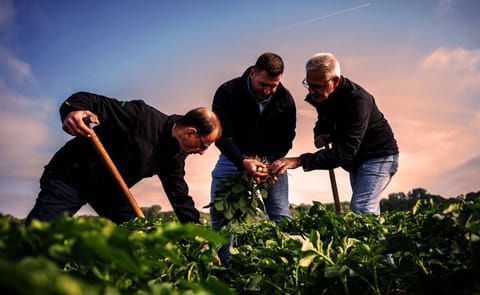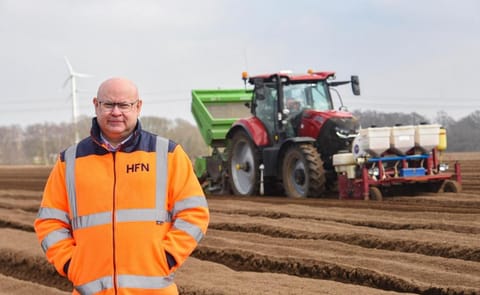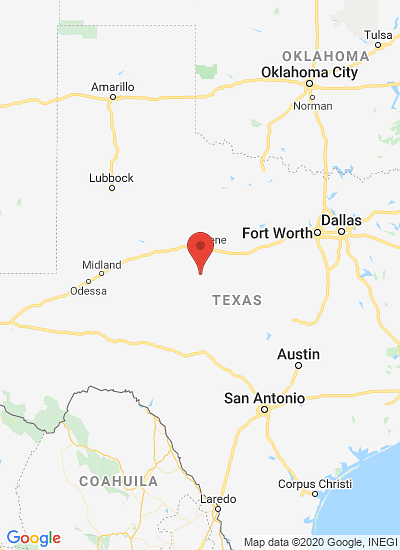The COTX08063-2Ru potato clone by the Texas A&M Potato Breeding Program is being touted as the best chance for Texas to enter into the french fry market. (Courtesy: Texas A&M AgriLife)
Texas A&M Potato Breeding Program highlights market, varietal expansions
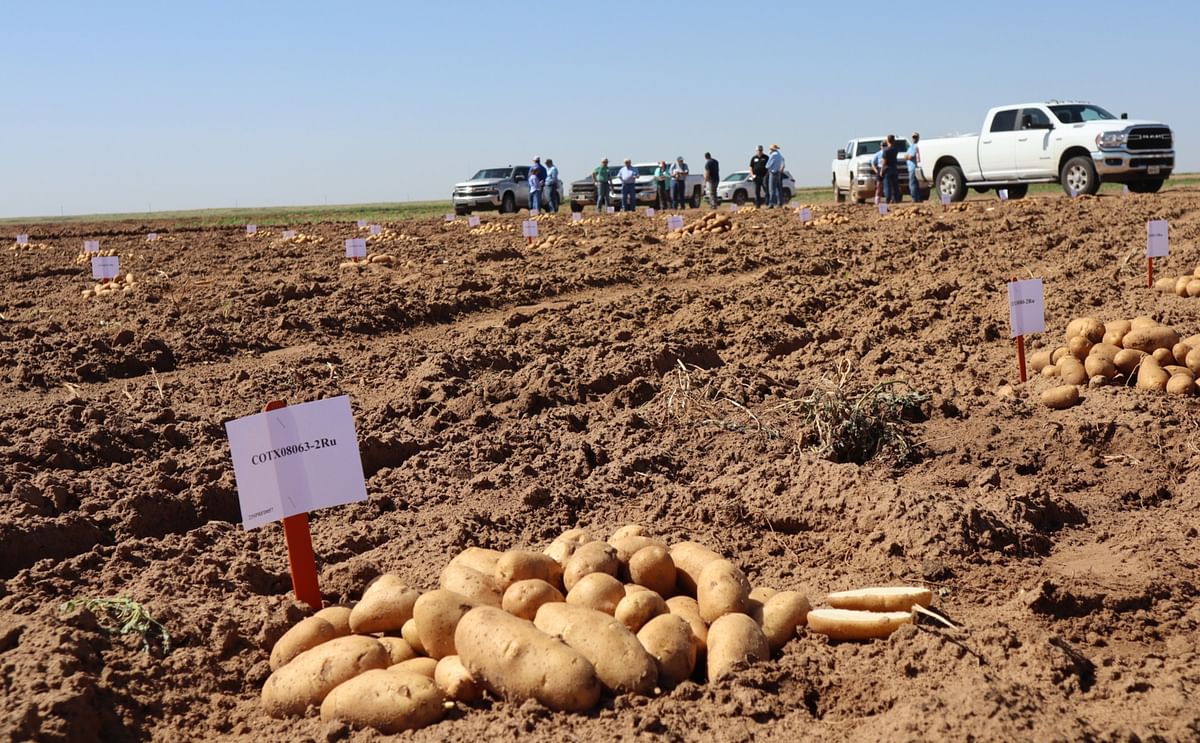
Advances, including Texas french fry variety and nutrition qualities, to be discussed at National Potato Expo in Austin.
The latest advanced potato clones from the Texas A&M Potato Breeding Program, especially those for the french fry and fresh markets, will be highlighted during the National Potato Expo by Isabel Vales, Ph.D., Texas A&M AgriLife potato breeder in the Department of Horticultural Sciences in the Texas A&M College of Agriculture and Life Sciences.
The Potato Expo, set for Jan. 10-11 at the Austin Convention Center in Austin, is the largest annual potato industry conference and trade show held in North America.
Vales said a significant advancement in the past few years is a potato clone, COTX08063-2Ru, that produces excellent french fries and can be grown in Texas.
Until then, no other clone could do so because high temperatures in Texas typically resulted in tubers with low starch that are unsuitable for the french fry market.
Isabel Vales:
"We are excited about the possibility of having a Texas-bred, Texas-grown, and Texas-processed french fry variety."
"Our research could open market opportunities for Texas producers to branch out into a new market class. This clone makes delicious french fries. Consumers will for sure enjoy them."
Vales will talk about the clone and its french fry processing potential at the Potato Expo during her" Cultivation Corner: Regional Breeding Program’s Contributions to the Industry" presentation organized by the U.S. Department of Agriculture National Institute of Food and Agriculture, USDA-NIFA.
The Texas A&M Potato Breeding Program is part of the Southwestern Regional Potato Cultivar Development Project, the multi-state project funded by USDA-NIFA.
The four regional potato research programs involved in the project include 12 land-grant universities across the nation and several USDA-ARS centers.
Experts will present a few mainstream varieties and exciting new clones they have in the pipeline, Vales said.
New potato varieties
At last year’s annual potato field day in the Texas South Plains, Vales and her team featured 134 potato clones – russets, chippers, reds, yellows, purples, smalls and fingerlings – including Texas-released varieties, advanced selections and some advanced clones from other collaborating breeding programs.
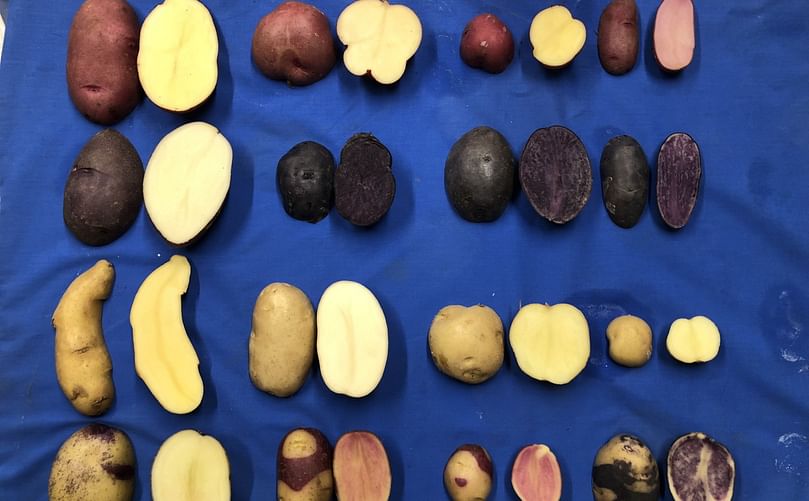
The Texas A&M Potato Breeding Program has created a wide variety of shapes, sizes and colors of potatoes for the specialty potato market. (Courtesy: Texas A&M AgriLife)
The Texas A&M potato varieties Vanguard Russet and Reveille Russet remain among the best clones in the program for the fresh market group, she said.
Both varieties have excellent tuber appearance and long dormancy and are tolerant to heat stress.
Several recent studies confirmed that Vanguard Russet is among the most heat-tolerant potato clones in the program; it produces a high yield of marketable tubers free from internal and external defects, which is a critical consideration in the context of being able to successfully produce potatoes in environments exposed to high temperatures during the growing season.
A few upcoming fresh market potatoes Vales highlighted to watch are ATTX10007-1Ru or "Agent Russet," as the team calls it. Vales said "007" has lighter skin than typical russets, but the shape and size of this oblong-to-long blocky potato are amazing. The total yield and marketable yield are very high.
Also, for a traditional fresh market russet, COTX10080-2Ru is an excellent new variety, Vales said. It has beautiful and intense russet skin texture, high yield, good size and shape, and has resistance to potato virus Y, PVY, and late blight, two of the most damaging diseases in potatoes.
Isabel Vales:
"The combination of physical attributes and disease resistance sounds too good to be true. But that is why we’re excited about it."
She said COTX10080-2Ru could replace the most popular fresh market variety Russet Norkotah and its strains, including Texas Russet Norkotah 278 and 296, which are asymptomatic to PVY.
While this sounds good from a potato production perspective, having the disease but not showing the symptoms, Vales said, is a nightmare for seed growers since it acts as a bloody Mary – not showing symptoms but could be spreading the disease.
Despite the excitement, Vales said there is a weakness in COTX10080-2Ru found in trial plots at Springlake. COTX10080-2Ru is sensitive to the widely used herbicide metribuzin.
Metribuzin is a main ingredient in several commercially available herbicide products. Screening for potential sensitivities to herbicides, including the chemical metribuzin, is typically done once the varieties reach Western Regional trials.
Vales said the Texas program also has promising advanced potato-chipping clones in the program, some of which are being tested nationally. In recent years, efforts have been made to incorporate more disease resistance to the chipping market group, including resistance to PVY, late blight and nematodes.
Isabel Vales:
"Another market sector that is fun to work with and has potential for expansion is the specialty group potatoes with many different sizes, shapes, skin and flesh colors, some of which have added health and nutrition benefits, such as having high antioxidant levels, carotenoids and minerals."
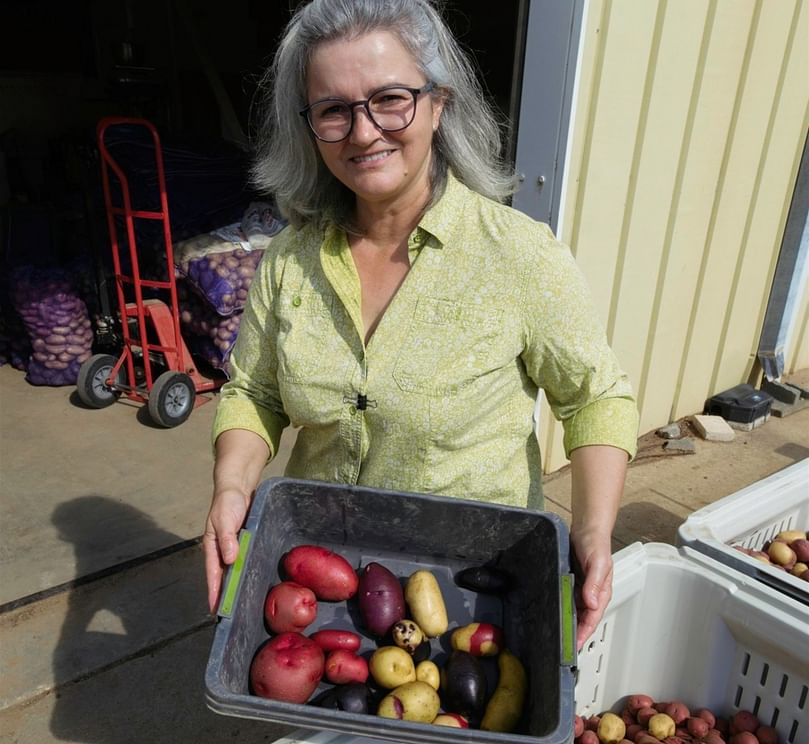
Isabel Vales, Ph.D., Texas A&M AgriLife Research potato breeder, shows off the variety of potatoes being bred by the Texas A&M Potato Breeding Program. (Courtesy: Texas A&M AgriLife)
A few advanced clones to keep an eye on are: COTX08365f-3P/P, a purple fingerling potato; PORTX03PG25-2R/R grows as red fingerlings; TX17734-1Y/Y produces yellow teardrop tubers; TX17797 –11Y/Y — yellow round tubers; ATTX88481-1P/W — amethyst skin with white flesh; TX17755-2Psplash — amethyst splashed skin; COTX10118-4Wpe/Y — purple eyes; TX17805-8R/R — red skin, red flesh; COTX15083-1R — red skin, white flesh; NDTX050169-1R — small red skin, white flesh; and several with bicolor skin.
Potato research
Selecting and developing varieties with improved nutritional quality is also an important aspect of potato research, Vales said. Disease resistance, shape, size and yield will remain a large part of the program, but researchers are seeking healthier baking, chip and fry potatoes.
The location where potatoes grow, soil and the environmental conditions the potato plants are exposed to all affect the yield, dormancy and nutritional qualities of tubers like protein, free amino acids, minerals, antioxidants, starch and sugar content, she said.
An article published in the Nature journal Scientific Reports highlighted a study to assess variation in the tuber-bound free amino acids in potato clones developed and maintained by the Texas A&M Potato Breeding Program to explore their genetic basis and to obtain genomic-estimated breeding values for applied breeding.
Free amino acids contribute to potato tuber’s nutritional value and processing quality. Ideally, the study said, breeders want potato cultivars with low free-asparagine and reducing sugars as desirable characteristics for processing purposes.
Breeders can use diversity panels to understand the genetic basis of the traits and to obtain breeding values for faster and more effective selection of superior parents and/or the advancement of better clones.
A similar study, published in the Frontiers in Plant Science journal emphasizes the genetic basis and breeding values of potato tuber mineral content. Potato tubers are a good source of minerals and contribute to ensuring good human nutrition since they provide 18% of the recommended dietary allowance of potassium; 6% of copper, phosphorus and magnesium; and 2% of calcium and zinc. As a market group, red-skinned potatoes had the highest amount of minerals.
In another study, Raman spectroscopy detects chemical differences between potato tubers produced under normal and heat-stress growing conditions. Published in Frontiers in Plant Science, Vales’ team and collaborators highlight their work surrounding heat stress.
In a separate, previous study, Raman spectroscopy was able to distinguish potato tubers of different varieties and even discern where they were produced.
Vales said the Texas A&M University Potato Breeding Program has selected potato clones under high-temperature conditions for many years. Several released cultivars are considered heat-tolerant based on high marketable yields and low internal and external tuber defects.
They believe Raman spectroscopy could be used as a replacement or complement to conventional chemical analysis to inspect the effect of heat stress on tuber chemical composition.
The Plant Genome journal highlighted another study by the group, genomic selection and genome-wide association studies in tetraploid chipping potatoes. This research laid the groundwork for implementing genomic selection in tetraploid potato breeding and understanding the genetic basis of chip processing traits, including chip quality, in potatoes.
Using genomic selection, breeders can predict and select traits that are difficult or expensive to measure, as well as those with low heritability that are beneficial, such as fry chip color and chip quality.
Vales said their research will benefit potato growers, the chip processing industry and consumers because of the improved ability to use genomic selection to predict cultivars with good chip quality, high specific gravity, high dry matter and high yield.
The Texas A&M Potato Breeding Program has benefited from applying molecular breeding approaches to better understand the genetic basis of traits and to implement marker-assisted selection for traits with discrete phenotypes caused by major genes, as well as for more complex traits with quantitative inheritance.


